 |
|||||||||||||
 |
 |
 |
 |
 |
 |
 |
 |
 |
 |
||||
 |
|
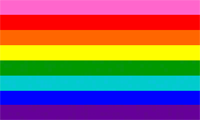 |
LGBT/Gay Pride (Original 1978 Design) The original gay pride flag was designed by Gilbert Baker, and debuted in 1978 at the San Francisco Gay and Lesbian Freedom Day. The pink strip represents sex, red for life, orange for healing, yellow for sun, green for nature, turquoise for art, indigo for harmony and violet for spirit. In 1979, when the flags were planned for mass-production, the hot pink and turquoise were removed from the design, since they were not commercially available. |
 |
LGBT+/Gay Pride (6 Colour) The six colour version of the mass-produced flag from 1979 spread from San Francisco to other cities, and soon became the widely known symbol of LBGT pride and diversity. It is even recognized by the International Congress of Flag Makers. There are many variations on the gay pride flag, specific to each country. (For example, deviations using the US Flag, the Union Jack, the Canadian Maple Leaf, the Southern Cross, Silver Fern, etc.) |
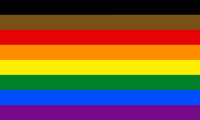 |
LGBTQIA+ / Gay Pride (8 Colour - 2017 Philadelphia) |
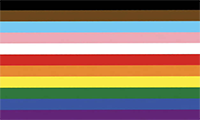 |
LGBTQIA+ / Gay Pride (11 Colour - 2018 Seattle) In 2018, the Seattle LGBTQ Commission, SEqual Seattle, and Mayor Jenny Durkan flew the 11 stripe flag over the city hall in Seattle, Washington, United States. The redesigned flag's intent was to bring visibility to the spectrum of gender identities, the transgender community, and people of colour in the LGBTQIA community. The Steaatle LGBTQ Commission explains, "The black and brown stripes represent people of color – and the pink, light blue and white stripes represent trans, gender non-binary, intersex and folks across the gender spectrum. These particular communities within the LGBTQ+ umbrella are often made invisible and disproportionately impacted by discrimination, but are integral to our community. We want to center those communities both symbolically and in daily engagement through our commission." |
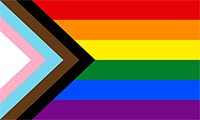 |
LGBTQIA+ Progress Flag Non-binary American artist and designer Daniel Quasar designed this reinterpretation of the 1978 Gilbert Baker design. The design sought to maintain the added inclusivity of the 2017 Philadelphia flag and the 2018 Seattle flag, while also improving the clarity of the original rainbow stripes, and placing the discriminated minorities at the forefront. Daniel Quasar states, "The arrow points to the right to show forward movement [...] and illustrates that progress still needs to be made. The new design forces the viewer to reflect on their own feelings towards the original pride flag and its meaning, as well as the differing opinions on who that flag really represents, while also bringin into clear focus the current needs within our community." From one flag reboot to another, the coloured stripes are imbued with different meanings. For Quasar, the light blue, pink and white stripes represent trans and non-binary individuals and the brown and black ones represent marginalised People of Colour (POC) communities. The black stripe has a double meaning as it is also intended for "those living with AIDS and the stigma and prejudice surrounding them, and those who have been lost to the disease." Quasar posted the flag on social media on 6 June 2018, and it immediately went viral. Quasar subsequently released the design under a Creative Commons License, allowing others to copy and make use of the work non-commercially.) To respond to numerous requests of redesigns accommodating other identities, Quasar even developed merchandising in which the flag's arrow and background are interchangeable. This initiative shows that even the design of the flag is always a work in 'Progress'. |
 |
Abrosexual Pride Abrosexuality is fluid sexual orientation, or a sexual orientation that may shift over time. Designed by a moderator of flags-for-us, it features a set of five horizontal stripes in shades of pink, white, and green. It’s unknown why these colors were chosen. |
 |
Asexual Pride The Asexual Visibility and Education Network created this flag in 2010, after seeking input and votes online. The flag premiered in 2011 at pride parades in San Francisco, London, Stockholm and Toronto. The field is divided into four vertical bars. The top three bars represent the three ranges of sexuality; The black bar at the top symbolizes asexuality, (either the lack of sexual attraction to anyone, or a lack of a self-sexual identity.) The grey bar represents Gray-A or demisexualism, (limited sexuality.) White represents sexuality. The fourth purple bar unites the three together and represents community. |
 |
Aromantic Pride Aromantic is the state where little or no romantic attraction to others exists; a non-romantic relationship. This flag features five horizontal bars. The first two bars are differing shades of green. Green is meant to represent the opposite of red, which is often associated with romanticism. The white, grey and black lines represent the differing spectrums of gender and sexual identity, as well as sexuality. |
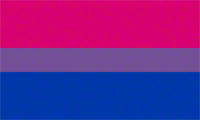 |
Bisexual Pride The bisexual pride flag was designed by Michael Page,and debuted in December of 1998 at the BiCafe's first anniversary party. The flag is an evolution of the pink and blue triangles, (an earlier symbol of the bisexual community,) and the resulting purple colour when they overlap, representing the middle ground. |
 |
Demisexual Pride |
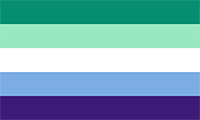 |
Gay Pride As the rainbow pride flag shifted to represent the expansive LGBTQIA+ community as a whole, some gay men felt the need for a flag to represent their identity within the community. In 2019 on the social media platform Tumblr, the five striped gay pride flag was proposed. It faced some resistance, and criticism for being a copy of the lesbian pride flag, but eventually gained acceptance as a standard pride flag over time. It features five colors (sometimes seven), ranging from green to white, then white to purple. The green and turquoise colors represent community and healing. White represents gender nonconforming, transgender, and non-binary individuals. And the blue to purple colors represent love, diversity and fortitude. The designer's name is unknown. |
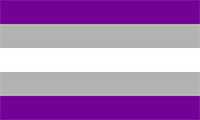 |
Grey Asexual Pride Gray asexuality is considered the gray area between asexuality and allosexuality, in which a person may only experience sexual attraction on occasion. This flag was designed by Milith Rusignuolo in 2013 to represent the greysexual community. Purple signifies someone who experiences no sexual attraction. The fade to white represents a signal experience of sexual attraction before shifting back to asexuality. |
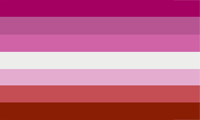 |
Lesbian Pride The design of this flag is a bit of an unknown, and while I have found some information on the symbology, the information has been inconsistent and unreliable. This flag premiered in 2010, and has been in use randomly throughout the community as a way to specify pride in lesbianism, independent of the grouping of the LGBT community that the rainbow pride flag (above) signifies. |
 |
Lesbian Pride The Labrys Pride Flag is a symbol for the lesbian community. The lavender field represents the lesbian community features a black triangle in the charge. The triangle is a symbol from Nazi Germany, which was used to designate prisoners with anti-social behaviour, including lesbians. The triangle includes a labrys, which is a double-sided hatchet or axe which is an ancient symbol from European, African and Asian matriarchal societies. The flag was created by Sean Campbell in 1999, and was first used nationally in 2000 for a Pride edition of GLT Magazine. |
 |
Omnisexual Pride Omnisexualism is a sexual attraction to humanoids, regardless of their sexual identity or gender. (This is commonly aligned with pansexuality.) The Omnisexual pride flag contains five horizontal lines. The first two lines are pink, representing a range of femininity. The center line is purple, representing agender identies, and the bottom two lines are blue, representing ranges of masculinity. The designer of this flag is unknown. |
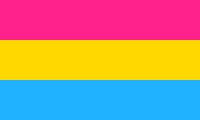 |
Pansexual Pride The pansexual pride flag was designed to increase visibility and recognition for the pansexual community, and appeared on the internet on multiple sites in mid 2010. The blue portion of the flag represents those who identify within the male spectrum (regardless of biological sex), the pink represents those who identify within the female spectrum (regardless of biological sex), and the yellow portion, found in between the blue and pink portions, represents non-binary attraction; such as Transgender and Intersex people. |
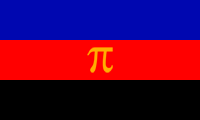 |
Polyamory Pride The poly pride flag consists of three equal horizontal colored stripes with a symbol in the center of the flag. The colors of the stripes, from top to bottom, are as follows: blue, representing the openness and honesty among all partners with which we conduct our multiple relationships; red, representing love and passion; and black, representing solidarity with those who, though they are open and honest with all participants of their relationships, must hide those relationships from the outside world due to societal pressures. The symbol in the center of the flag is a gold Greek lowercase letter 'pi', as the first letter of 'polyamory'. The letter's gold color represents the value that we place on the emotional attachment to others, be the relationship friendly or romantic in nature, as opposed to merely primarily physical relationships. The flag was created by Jim Evans.
|
 |
Polyamory Pride The red heart with the blue inifinity logo is the most widely recognized symbol of polyamory. This pride flag is a white field with that symbol centered. |
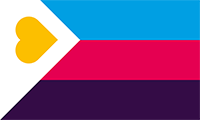 |
Polyamory Pride (2022 Howell) The polyamory community on polyamproud.com voted in 2022 for a new pride flag, and this design by Red Howell was the winner. The white chevron indicates possibility, hope and neutrality or poly relationships. The blue stripe represents openness and honesty; magenta representing desire love and attraction; purple representing a united non-monogamous community. The gold heart represents energy and perseverance. |
 |
Polysexual Pride (Helms) The three colour polysexual flag represents the attraction to multiple or alternate genders and multiple or alternate sexualities through three horizontal stripes, each at 1/3 of the field. The pink relates to either female or feminine qualities, while the blue relates to male or masculine qualities. The green center bar represents non-binary genders and sexualities. The specific source of this flag's design is unknown. |
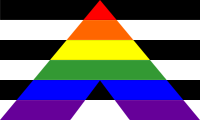 |
Straight Ally Flag A straight ally or heterosexual ally is a person who supports equal civil rights and gender equality for the LGBTQ+ community, who themselves identify as heterosexual. The design of this flag features a caret, meant to represent the A of the word ally, in rainbow stripes to represent the six-colour LGBTQ pride flag (above). This is set on a field of six black and white stripes, meant to represent the heterosexuality of the individual supporting the community. |
 |
|
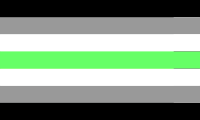 |
Agender Pride Agender is the association of one without a particular gender. Created in 2014, the agender flag has seven horizontal stripes. The black represent the absence of traditional binary gender. Grey represents those with a partial gender identity. Green represents those with a non-binary gender (neither exclusively male or female). Green was chosen for this as it is on the opposite end of the colour spectrum from purple, which is often used to identify traditional binary genders (a combination of pink [feminine] and blue [masculine]. |
| Androgyny Pride Androgyny is the combination of masculine and feminine features, resulting in an abiguous/gender-neutrality. The androgyny pride flag's origin is unknown, but is meant as a symbol for androgynous people of all sexualities. The grey field represents the ambiguousness of androgynous people, and the blue and pink equal sign represents an equality between genders. |
|
 |
Aroace Pride Aroace is a portmantau for people who are both aromantic (aro) and asexual (ace) or on the aromantic spectrum (aro-spec) and the asexual spectrum (ace-spec). Five horizontal bars span the field, from the top: orange representing community; yellow representing love and relationships outside of the conventional; white represents wholeness; light blue followed by dark blue represent the spectrum of identities and experiences. |
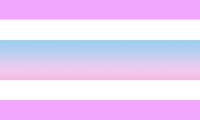 |
Bigender / Intersex Pride |
 |
Demiboy Pride A demiguy (also called a demiboy, demiman or demimale person) is a gender identity describing someone who partially, but not wholly, identifies as a man, boy or otherwise masculine, whatever their assigned gender at birth. They may or may not identify as another gender in addition to feeling partially a boy or man. The field is divided into seven equal horizontal lines; dark grey at the top and bottom represent partial gender identity, the lighter grey an alternate partial gender identity, the blue for masculinity, and the white for agender or non-binary. |
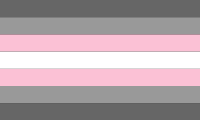 |
Demigirl Pride A demigirl (also called a demiwoman or a demifemale person) is a gender identity describing someone who partially, but not wholly, identifies as a woman, girl or otherwise feminine, whatever their assigned gender at birth. They may or may not identify as another gender in addition to feeling partially a girl or woman. The field is divided into seven equal horizontal lines; dark grey at the top and bottom represent partial gender identity, the lighter grey an alternate partial gender identity, the pin for femininity, and the white for agender or non-binary. |
 |
Genderfluid Pride The genderfluid pride flag is another sexual identity pride flag used by those who do not identify with a binary male/female gender system. The five horizontal bars start at the top with pink, for female/feminity. The three center bars are black, purple, and white - representing the blurred lines of neutral and fluid genders. The bottom bar unites the meaning with the top bar by symbolizing masculinity/male attributes. |
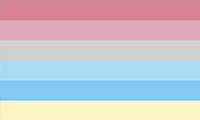 |
Genderflux Pride In 2012, an unnamed individual presented the genderflux pride flag on the social media platform Tumblr to represent individuals who have experienced fluctuations in their gender identity over time. The Genderflux Pride Flag features a set of five horizontal stripes in shades of pink, yellow, green, blue, and purple. The multitude of colors represent how a fluidflux person can be fluid between multiple genders, with the paler colors at the bottom of the flag representing fluctuations in those genders, and the black line representing agender. |
 |
Genderqueer Pride (Roxie) The Genderqueer pride flag was accepted by the genderqueer (persons who do not identify themselves by one specific gender) community in September of 2010. The field of the flag is divided into three horizontal stripes, the top lavender stripe representing a mix of blue and pink, (traditional male and female colors) meant to represent those under the genderqueer umbrella who feel they are both male and female in identity. The greenish chartruse color is the inverse of the lavender color, ; meant to represent individuals who feel they are neither male nor female in identity, and the white meant to represent individuals falling completely outside of the gender binary. The design is by Marilyn Roxie. Version two of the design was replaced by this current version (3) in June, 2011 |
 |
Genderqueer Pride (Alternate) |
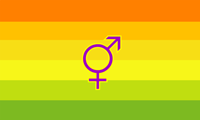 |
Hermaphrodite Pride (Mars/Venus) The Herm-Pride flag is based on the principle that yellow represents a neutrality in gender, (where pink is typically representatie of females, and blue of males.) Taking the rainbow spectrum from the gay pride flag, the herm-pride flag opens the spectrum between the colours that border the yellow, (orange and green), and create a six-barred field with shades of yellow ranging from orangish to greenish. The center of the flag holds a modified mars/venus symbol to represent both genders. The designer of this flag is unknown. |
 |
Hermaphrodite Pride (Mercury) The Herm-Pride flag is based on the principle that yellow represents a neutrality in gender, (where pink is typically representatie of females, and blue of males.) Taking the rainbow spectrum from the gay pride flag, the herm-pride flag opens the spectrum between the colours that border the yellow, (orange and green), and create a six-barred field with shades of yellow ranging from orangish to greenish. The center of the flag holds a modified mercury symbol to represent both genders. The designer of this flag is unknown. |
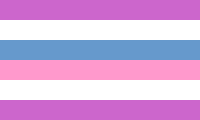 |
Intersex Pride (Phox) Intersex is sexuality that does not fit typical binary notions of male or female. Created in 2009 by Natalie Phox, this version consists of five horizontal stripes coloured (from top to bottom) lavender, white, a double-width stripe with a gradient from blue to pink, white and lavender. The gradient represents the range of sexes between male and female, and the lavender represents a combination of male and female traits. |
 |
Intersex Pride (OIIA) The Intersex flag was created by Organisation Intersex International Australia in July 2013 to create a flag "that is not derivative, but is yet firmly grounded in meaning". The organisation aimed to create a symbol without gendered pink and blue colors. It describes yellow and purple as the "hermaphrodite" colors. The organisation describes it as freely available "for use by any intersex person or organisation who wishes to use it, in a human rights affirming community context" |
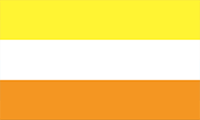 |
Maverique Pride In 2014, Vesper H. coined the term "maverique" to describe their own gender. The word comes from "maverick" and the French suffix "-ique," and can be used as a noun ("some maveriques") or an adjective ("some maverique people"). Maverique is a gender identity that falls under the nonbinaryumbrella term. It is defined as an identity that is not the absence of gender, or an apathy towards gender, but a present feeling of gender. This feeling of gender is completely independent from male, female, neutral, or anything derived from any of them. However, maveriques can be multigender with their other genders being related to maleness, femaleness, or neutrality. |
 |
Neutrois Pride Neutrois is a non-binary gender identity which is often associated with a "neutral" or "null" gender. It may also be associated with genderlessness, and shares many similarities with agender - people who consider themselves neutrally gendered or genderless, but some may identify as both, while others may prefer one term or the other. This field has three equally distributed horizontal lines; white for neutral, unidentified or questioning gender, green for non-binary gender, and black for agender, asexuality, or third gender. |
 |
Non-Binary Pride |
 |
Pangender Pride Pangender (or omnigender) is a non-binary gender which refers to a wide multiplicity of genders that can (or not) stretch to the infinite (meaning that this experience can go beyond the current knowledge of genders). This experience can be either simultaneously or over time. This flag was designed in 2015, and was based on the agender flag. It consists of seven stripes coloured (top to bottom) yellow, pink, violet-pink, white, violet-pink, pink, yellow. The colors are very bright so that they represent the multiplicity of genders (because the white light, in the electromagnetic spectrum, is a combination of all colors). Yellow represents all the genders that are not related to female and male. Light red represents the transition to the genders which are related to female and male. Light violet-pink represents the combination of female and male. White represents the blend of all these genders. |
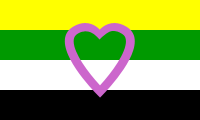 |
Skoliosexual Pride Skoliosexuality is the self-identity of, or attraction individuals with, a non-binary gender. The field contains four yellow horizonal bars; yellow (representing the non-binary gender,) green (representing those who identify with alternative genders [bi-gender, genderqueer, and other non-binary gender identities]), white (representing an inclusion of all non-binary identities,) and black (representing an inclusion of those without a gender identity). In the center, a lavender heart which represents love for those outside of binary-genders. The heart is open in the center, representing acceptance. |
 |
Transgender Pride (Helms) The three colour transgender flag was designed by Monica Helms and made it's debut in a Phoenix, Arizona pride parade. It is the most widespread and recognized symbol of the transgender community. The light blue is the traditional color for baby boys, pink is for girls, and the white in the middle is for those who are transitioning, those who feel they have a neutral gender or no gender, and those who are intersexed. The pattern is such that no matter which way you fly it, it will always be correct. This symbolizes us trying to find correctness in our own lives. |
 |
Transgender Pride (Pellinen) This version of the transgender pride flag was created by Jennifer Holland in 2002. She was unaware of the Helms flag (above) and wanted to give a symbol to the transgender community. The five horizontal striped field of the flag represents female (pink at the top) and male, (blue at the bottom), with three shades of purple to represent the diversity of the transgender community, and the genders other than 'male' and 'female'. More information on this design is available at http://www.transflag.org |
 |
Transgender Pride (Holland) The Queer Nation's Transgender Focus Group, Transgender Nation, created this flag in 1991 in San Francisco, California, USA. The interlocked gender symbols in the charge of the flag are meant to represent various transgendered people working in unity. |
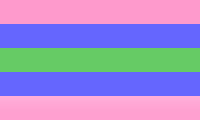 |
Trigender Pride Trigender is defined as the act of identifying as having three genders; male, female, and/or any non-binary gender- either simultaenously or varying in between. Like many gender identity flags, the design is based on the horizontal bar schema of the 1978 LGBT pride flag. This flag features five horizontal bars in pink, blue and green. Pink represents feminine gender identity, blue represents masculine identities, and green represents a non-binary third gender. |
 |
|
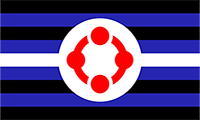 |
The Fetish Pride Flag |
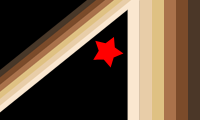 |
The Armpit Fetish Flag The right of the field contains six vertical lines, representing the body; the six lines represent the six continents/land masses of the world, and the array of skin tones meant to encompass all races. At an angle from the upper right to lower left is a thinner band of the same six bars, representing an arm, coming to an apex in the upper right corner, to represent the armpit. Near the center of the field, a five pointed star signifies the five senses, the top point of the star pointed towards the armpit. The red of the star represents the blood which flows within all armpit enthusiasts. |
 |
BDSM Pride (metal) The BDSm Rights Flag is intended to represent people who's sexual preferences include Bondage and Discipline, (BD,) or Sadism and Masochism (SM) regardless of their sexual preference. The triskelion was meant to represent the idea that fetishist deserve the same rights as anyone else, without discrimination for their sexual practices. The triskelion is meant to represent the threes of BDSm: Dom, sub and Switch; and Safe, Sane and Consensual. The triskelion is a symbol which dates back thousands of years, and was adopted as a symbol which the BDSm community could recognize without the mainstream culture being aware of it's meaning. |
 |
BDSM Pride (mainstream) This is the most widely recognized BDSm flag in the community to date. While the original flag was meant to contain a metallic triskellion, this is not possible to represent in flag form, so the adaptation to the left was established. It is a derivation of the leather-pride flag (below) with a triskelion in the charge of the flag's field. |
Bear Pride
|
|
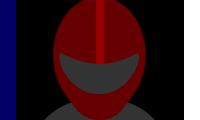 |
Biker Pride The biker pride flag (also known as the biker gear pride flag) has a black field with a dark red oval in the center, which represents a biker helmet. The helmet features a grey visor shape, along with a circular shape at the bottom of the flag which represents the body of the biker. The red is meant to indicate the blood of all bikers, symbolic of a united passion. The grey biker and visor represent a universal tie to all genders and all races. The blue and white vertical stripes on the left and right represent a nod to the leather community, which is a common thread among biker gear. |
 |
Boi / Boy Pride Flag The boy pride flag made it's debut at Mid-Atlantic Leather 1998 in the United States, by creator Keith P., who got the idea after meeting Tony DeBlase, the creator of the Leather Pride Flag. The design was based on the leather pride flag, equal number of stripes, but they are diagonal from left to right, left higher symbolizing the Sir, and the right lower representing the boy. The heart was moved to the right to show where the boys heart is. and the blue changed to green to represent boy. |
 |
Boot Fetishists Flag This boot fetishists flag is less-widely accepted than the one pictured above. It is a derivation of the Leather Pride flag, with the red heart removed from the canton, and a black boot featured in the charge. The origin of this flag is unknown. |
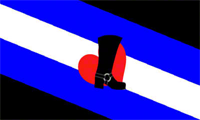 |
Bootblack Pride Flag The bootblack flag was designed and created by Jesse “Spanky” Penley from Kansas City, Kansas, USA. The flag premiered at International LeatherSir/ International Leatherboy weekend in Atlanta, GA on Oct 6th, 2005. Using the Leather Pride colors, he used a diagonal stripe to differentiate from the leather pride flag. The flag only uses three stripes, two blue, and one white. The width of the stripes, signify the wide range of people who are, and appreciate boot blacks. The unisex boot, stands for the non-gender specific nature of boot blacking. The large red heart positioned behind the boot, signifies the heart that the bootblack puts behind his or her boots. |
 |
Chav Fetish Pride Flag Chavs, or Charvers, are somewhat specific to the English culture. The flag is a recreation of the Burberry brand tartan pattern, which is a brand name of clothing commonly associated with the chav sub-culture. This flag was seen first in the London Gay Pride of 2008. |
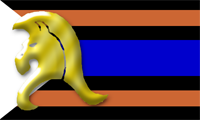 |
Cowboy Pride Flag
|
 |
Cowboy Gay Pride Flag Prior to Sean Campbell's design, Frank Harrell (a.k.a. Cowboy Frank) designed a symbol for the gay cowboy fetishist community in March of 1998, which is more widely recognized as the 'official' symbol of the cowboy community. His design featured a cowboy hat image in the canton of the gay pride rainbow. Because the image of a cowboy hat could not be produced as a flag without screen printing, I contacted Frank, and he sanctioned the "true flag" version, shown here. An etymology of the flag can be found here. |
 |
Fat Fetishism The fat fetishism flag is a horizontally striped field, with five equally spaced stripes. From top to bottom: black, pink (strawberry) [E0167F], cream (french vanilla) [FFF9BD], brown (chocolate) [604043], and black again. The colours are a play on neopolitan ice cream, each colour representing a distinct aspect of the fetish. Created by Kevin Seguin, (also known as 'The Cosmopolitan',) as a symbol of the fat fetishism community, who describes the flag's entomology in great depth. View the full description and symbology by clicking here. |
 |
Feather Pride - Drag Pride The feather pride flag was designed as a symbol for the Drag community, which encompasses people of all sexual preferences who are into Drag Queens, Fancy Kings, their courts, and other fetishes. The phoenix which the gay community has embraces for it's own as a symbol of rebirth, it is symbolic display here for the fires of passion which the drag community had in the early days of HIV/AID epidemic, raising funds for research within the gay community. The flag was created by artist Sean Campbell in 1999 and first national use as an graphic element for a pride edition in GLT Magazine. |
 |
Feline Play Pride Flag Designed in 2018 by "MO", the feline play pride flag field features diagonal orange, dark gray, and white stripes, representative of the common color palette of calico cats. The red yarn captures both the whimsy and potential of mass destruction inherent in the feline personality. |
 |
Foot/Feet Fetishist Pride Flag The foot fetishist pride flag is a black field with white footprints in the charge, and a woven red and blue border. The origin of this flag, or it's meaning are unclear. If you have information regarding it's creation, please contact me. |
 |
Foot/Feet Fetishist Pride Flag This foot fetish flag is an unconventional, not complying with the international 2:3 ratio layout. It's unusual 1:3 ratio is meant to be reminscent of the shape of a foot in profile. Designed under the pseudonym Uboa. The black field represents solidarity with fellow foot fetishists and a sense of community. The blue stripe is a call back to other fetish pride flags and symbolizes foot fetishism as one of a larger community of fetishes, each one unique and deserving of respect. The heart symbolizes love, including the love for feet, which is white to symbolize that it is undefined, and up to the person looking at it to "fill it in" with that which they personally desire about feet. Meant to be inclusive of all aspects of foot fetishism and related fetishes (hosiery, footwear, footjobs, submission, crushing, shrimping, etc.). The ten stars represent the ten toes on the average pair of feet, and therefore they symbolize feet in general. They're on the bottom of the flag as that is where the foot is in relation to the body. Red symboilized the color of life and vitality and love. |
 |
Freak Pride Flag |
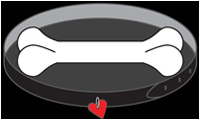 |
Furry Pride (Canine) |
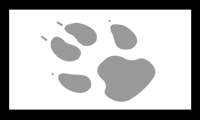 |
Furry Pride (Canine) This simple flag also represents the "furry" canine community; (also sometimes referred to as Yiffy, Anthro or Morph communitiy.) The origin of this flag, and it's acceptance by the community could not be verified. |
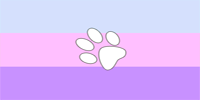 |
Furry Pride (Feline) / Kitten Pride This flag represents the "furry" feiline community; (also sometimes referred to as Yiffy, Anthro or Morph communitiy.) The pale blue at the top of the field is meant to represent the male gender; the pink in the center of the field is meant to represent the female gender, and the pale purple at the bottom of the field is meant to represent the transgendered. The center of the field is a feline paw print, representing feline anthropormorphism across all gender boundaries. The flag was designed by 'Ponygirl Linsey', and was posted on ponyplay.org, a furry community based in Florida, USA. |
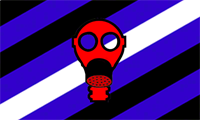 |
Gasmask Fetish Pride Flag The field is a tribute to the leather pride flag, but the lines have been angled to represent the airflow variations of gasmasks. In the center is a red gasmask icon, the red symbolizing the barrier between common air and the air available within the gasmask.. |
 |
Gothic Sexuality Pride Flag The gothic sexuality pride flag came about as an evolution of a symbol which was established by Erik Dunesque of London, England established in 1990 for people interested in the gothic sex scene to identify each other easily. The symbol is the Eye of Horus, reversed, and is in the charge of the flag in purple, representing funereal colours. The black field represents the night, and the dark sensuality of gothic sexuality. |
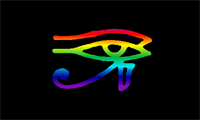 |
Gothic Sexuality Pride Flag, LBGTQ Version The gay gothic sexuality pride flag is an obvious derivation of the original 1990 version (above) for the gay community interested in gothic sexuality. Other versions of the gay pride version show the rainbow reversed, with purple at the top, as a nod to the original purple design of the flag. |
 |
Ownership Pride Flag The Ownership Pride Flag was created by Tanos in the United Kingdom in 2006, as part of the Ownership Icons. The black and white striped field represents the clear distinction between owners and property, as well as to represent the bars of a cage or jail cell on the uniforms of convicts sentenced to penal servitude. The charge features a red shield, with a thick circle, representing the collar, and owned submissives and slaves. |
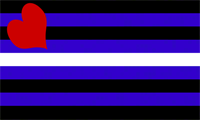 |
Leather Pride Designed by Tony DeBlase, the flag debuted in Chicago, Illinois, USA in May of 1989 as a symbol for the leather subculture. The designer of the flag states that the colours of the flag are to be determined by the individual. Although the flag is common in the gay community, it stands as a symbol to the fetish community at large, regardless of sexual orientation. |
 |
Longhaired Fetish Pride Flag Presented to the longhaired community on 20 April, 2009. While there were symbols for the longhaired community, none of them could be translated into actual fabric flags, and the designer felt it was time to have a symbol which was meaningful to those in the longhaired community, but which had no particular meaning to others. The field is striped in red, purple and blue, and has a circular shape at the top of the charge, (representing the top of a head,) and expanding strands of colour coming downward, in the various colours of hair which exist in all creeds and races of people. See the complete etymology here. |
 |
Master/Slave Pride Unveiled during the Master/Slave Conference on July 29, 2005, this flag was designed by Master Tallen of Washington, DC, USA. The black field has an indented white border on a black field. The vertical stripe is a universal symbol of dominance. The set of three horizontal red stripes is a universal symbol meaning passive of submissive. The flag was created to provide a universal symbol that represents the foundation of the Master/Slave relationship, and create a symbol of unity and pride. |
 |
Military Uniform Fetish Flag |
 |
The Muscle Pride Flag The muscle pride flag was designed as a symbol for muscle enthusiasts, and those with a fetishism for muscular individuals, or for building muscle mass. The field is comprised of six green horizontal bars, in two gradients. Green symbolizes growth, while the horizontal bars are an homage to the gay pride flag. The charge on the flag is a "triskle" made up of three muscular arms flexed to make a biceps pose; representing the three core components of the fetish: muscle development and growth, height growth, and cock/breast growth. The flag was designed by Jonathan Thorn in 2013. |
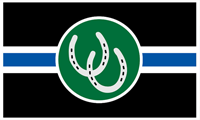 |
Pony Pride Flag The pony pride flag was created by Carrie, (a.k.a. Mystic Storm), who presented the flag to the crowd at the Florida Fetish Weekend in October of 2007. The black field represents a tie to the leather community; the white bar represents the true/pure inner spirit within each pony. The blue line across the centre represents the ponies who strive to exceed at their craft, as well as the competition aspects of pony play; it's also a nod to denim, for all the cowboys and cowgirls who love their ponies. The green circle represents the grass and nature of a horse's environment, and the overlaying shoes represent the pony in it's natural environment, and the unification of all ponies. |
 |
Puppy Pride Flag / Dog Play Pride While I have not been able to locate the creator or debut date of this flag, I recall reading the lines were a tribute to the leather pride flag (above), with the colours representing different colours of dog fur. If you have information regarding the source of this flag, please contact me. |
 |
Puppy Pride Flag / Dog Play Pride This version of the Puppy Pride flag was created by 'Nipper', who submitted it to a Yahoo! Group, "PupOut!". This flag was voted by 300+ members as the best choice. The flag featured the same black, blue, and white lines as the leather flag (above), but the red heart in the canton has been replaced by a paw print. |
 |
Puppy Pride Flag / Dog Play Pride This is another puppy pride flag which is commonly found. The flag featured the same black, blue, and white lines as the leather flag (above), but the red heart in the canton has been replaced by a canine head (which appears to be a great dane.) The origin of this flag is unknown, but if you have information regarding it's source, please contact me. |
 |
Puppy Pride Flag / Dog Play Pride This is yet another puppy pride flag which is commonly found. The flag featured the same black, blue, and white lines as the leather flag (above), but the red heart in the canton has been replaced by a large red bone in the charge. The origin of this flag is unknown, but if you have information regarding it's source, please contact me. (Much like real canines, getting a general consenus among this fetish community to choose a single flag to stand above the others to represent them has been... difficult.) |
 |
Puppy Rubber Flag, Unified Designed by pups Pongo and Thor, a symbol to unify both leather pups and rubber pups under one flag. The traditional leather fetish flag fills the left field, the traditional rubber pride flag fills the right, with a superimposed sillouhette of a white pup in the center to link the two; the white pup symbolizes pride, strength and fidelity, a pup always ready to protect his master. The acceptance of this flag by the community of this fetish group could not be verified. |
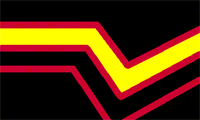 |
Rubber Pride Flag / Latex Pride Flag The international Rubber Flag was designed by Peter Tolos and Scott Moats in 1994 as a means to identifying like-minded rubberists. The design reflects the sensory, sensual, and mental passion for rubber: Black - our lust for the look and feel for shiny black rubber. Red - our blood passion for rubber and rubberists. Yellow - our drive for intense rubber play and fantasies. The chevron represents the kink enjoyed by many rubberists. [large version] |
 |
Skinhead Fetish Pride Flag The gay skinhead pride flag was created for the 10th anniversary of FENIX Global Skin Movement in an effort to unite skins behind one symbol. Designed by SkinDavid and Shadowskin in 2006 in Antwerp, Belgium. The laurel wreath is meant to represent the unity and brotherhood of the skin movement. |
 |
Skinhead Fetish Pride Flag, LGBTQ+ Version The gay skinhead community often battle the stereotype of racist and neo-nazi skinheads. The gay skinhead culture is generally not racially biased in any way. The flag's specific origin is unclear, but is a modified version of the gay pride rainbow, with a skinhead outline in the charge and a boot in the fly. |
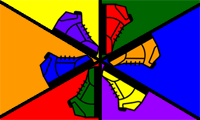 |
Sneaker Fetishist Pride Flag This colorful six sneaker array represents the six continents (land masses) of the world. The seven colors of the flag; red, yellow, orange, green, blue, purple and black represent the flags of all nations of the world, and celebrate the diversity in types of sneaker, and the diversity of those with sneaker fetishism. The thick black soles of the sneakers represent the hardships that the community has faced in gaining acceptance; all sneakers point inwards to signify the journey together. Flag design under the pseudonym OsirisSniff. |
 |
Switch Pride Flag The switch pride flag was designed in January 2009 by an unknown person in Washington, DC. Though the flag was intended as a first draught, it has already been used in pride parades in the US. The flag is an obvious derivation on the Leather Pride flag (above) with the heart moved to the charge of the flag, and red arrows to represent the role of the Switch. |
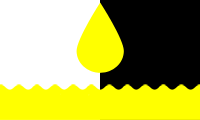 |
Urine Fetishism Pride Flag Also known as the Urolagnia Pride Flag, (or 'Piss Pride',) this fetish pride flag was initially seen in New York City Pride in 2013. The field is vertically divided into white and black, representing the two sides of urolagnia fetishism, the 'pisser' and the 'pissee', the top and the bottom. The bottom of the field is a yellow band with a waved pattern at the top with eleven peaks and vallies, and a large yellow waterdroplet in the center, feeding the pool below. The 11 waves, (or the number 11) is meant to represent the 11 regions of the world, unifying all urolagnists worldwide under one symbol of their pride. |
| While I have tried to encompass as many pride flags as I could, this does not mean that this is the definitive list of flags. The flags represented here are the most commonly recognized and identifiable flags. If you know of a flag which is not on this page, but which you feel should be added to the list, please let me know by clicking here. |
| click here for reposting requirements and copyright information | |||
design by:.gfg llc • box 11721 • syracuse, ny 13218-1721 usa Friend me on FaceBook® |